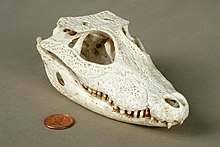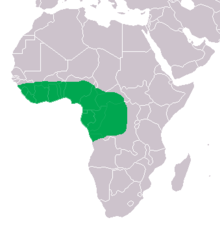Common crocodile
| Common crocodile | ||||||||||||
|---|---|---|---|---|---|---|---|---|---|---|---|---|

Common crocodile ( Osteolaemus tetraspis ) |
||||||||||||
| Systematics | ||||||||||||
|
||||||||||||
| Scientific name of the genus | ||||||||||||
| Osteolaemus | ||||||||||||
| Cope , 1861 | ||||||||||||
| Scientific name of the species | ||||||||||||
| Osteolaemus tetraspis | ||||||||||||
| Cope, 1861 |
The stump crocodile ( Osteolaemus tetraspis ) is a member of the family of real crocodiles and is the only recent member of the genus Osteolaemus . It is at home in western Africa as well as in central Africa.
features
The crocodile is one of the smaller crocodile species. It got its name from its blunt (flat) snout. The strong armor , which consists of heavy back and neck plates, is striking . The eyelids of this type are also ossified and the abdominal and side shields are also reinforced by skin bones. The stump crocodile can be up to 190 cm long and is one of the few small crocodile species. Adult crocodiles are uniformly dark in color; as young animals they have a drawing made of black transverse bands and a yellow drawing on the side, the rest of the body is dark brown.
distribution
Like the West African armored crocodile ( Mecistops cataphractus ), the stump crocodile also lives in fresh water in West Africa and its distribution here is limited to the tropical areas. Today it is believed that two large populations of the species exist. The first lives in the area from Senegal to Angola , the second from northeast Zaire to Uganda , but there are no more precise data. These crocodiles apparently prefer shallow, slowly flowing watercourses and floodplains as their habitat. There are no reports of finds in brackish or salt water .
Way of life
Crocodiles mainly live in permanent pools, swamps and rainforest areas with slowly flowing fresh water. Occasionally there are also reports of individuals in isolated savannah pools, where holes in the ground are occupied during the dry season. The crocodile is nocturnal. It spends most of the day either in caves that are created by the crocodile and whose entrance can be below the surface of the water, or under tree roots. The crocodiles usually emerge at night and feed either near the water or on land, especially in covered and forested areas.
Common crocodiles live solitary except during the mating season. Female crocodiles build their nesting mounds at the beginning of the rainy season. The nest, located near the water, consists of a heap of collected, moist, rotting vegetation, on which the approximately 7 cm large eggs are incubated by the heat generated by the decomposition of the plant material. A small number of eggs - around 10-20 - are laid, with the incubation period being 85-105 days. Newly hatched young animals measure around 23–28 cm. The female guards the nest during the breeding season, and after hatching, as the young can be eaten by a wide variety of predators (birds, fish, mammals and reptiles, including other crocodiles).
The diet of the common crocodiles consists mainly of softshell turtles , fish , crustaceans and frogs . They are nocturnal hunters and, unlike most other crocodiles, spend very little time basking.
In Gabon there is a special clade of crocodiles in a cave system . These were only discovered in 2008. They are almost blind , orange in color, and feed on bats . The population is said to have split off a few thousand years ago, but the gene pool is very small, which ensures a high mutation rate . The total number of animals was estimated to be less than 50 specimens.
Systematics
Based on a molecular-biological investigation in 2009, the previously monotypical genus Osteolaemus consists of three species. According to this study, Osteolaemus tetraspis should only apply to the population in the Ogooué in Gabon . The scientific name Osteolaemus osborni is to be used for the animals from the Congo river basin . The species was scientifically described in the year by the American herpetologist Karl Patterson Schmidt under the name Osteoblepharon osborni . The West African crocodiles of the genus Osteolaemus are also said to form a new species that has not yet been described.
Endangerment and preservation
In the red list of endangered species, the genus Osteolaemus is listed as endangered ("VU / vulnerable").
Common crocodiles are often kept and bred in zoos. With around 90 holdings, of which around 20 are in German-speaking countries, the crocodile is now quite well represented in European zoos. The European stud book is kept at Leipzig Zoo . Although species status has been postulated for the three known Osteolaemus forms, 25–28% of the European and North American zoo populations are hybrids . The aim is to breed pure lines in the future and, where necessary, to exchange animals between EAZA and AZA zoos
literature
- Joachim Brock: Crocodiles - A life with armored lizards. Natur und Tier Verlag, Münster 1998.
- Charles A. Ross (Ed.): Crocodiles and Alligators - Evolution, Biology and Distribution. Orbis, Niedernhausen 2002.
Individual evidence
- ↑ a b Osteolaemus tetraspis (Cope, 1861). crocodilian.com, accessed May 10, 2020 .
- ^ Mitchell J. Eaton: Crocodiles: Status, Survey and Conservation Action Plan . Ed .: SC Manolis, C. Stevenson, IUCN Crocodile Specialist Conservation Group. 3. Edition. 2010, Dwarf crocodile Osteolaemus tetraspis , p. 127-132 ( online [PDF]).
- ↑ Uwe Richter: An offspring of the stump crocodile , In: Salamandra. 17 (3-4), 1981, pp. 194-197
- ↑ Dwarf Crocodile. The Animal Files, accessed August 7, 2017 .
- ↑ Daniel Lingenhöhl: Why these crocodiles are orange. In: Spektrum.de . February 2, 2018, accessed July 15, 2020 .
- ^ A b Mitchell J. Eaton, Andrew Martin, John Thorbjarnarson, George Amato: Species-level diversification of African dwarf crocodiles (Genus Osteolaemus): A geographic and phylogenetic perspective. In: Molecular Phylogenetics and Evolution. Volume 50, Issue 3, March 2009, pp. 496–506, doi: 10.1016 / j.ympev.2008.11.009 .
- ^ Franke, Franziska Anni; Schmidt, Fabian; Borgwardt, Christian; Bernhard, Detlef; Bleidorn, Christoph; Engelmann, Wolf-Eberhard & Schlegel, Martin (2013). Genetic differentiation of the African dwarf crocodile Osteolaemus tetraspis Cope, 1861 (Crocodylia: Crocodylidae) and consequences for European zoos. Organisms Diversity & Evolution. 13 (2): 255-266. doi: 10.1007 / s13127-012-0107-1
- ^ Schmidt, KP, 1919. Contribution to the herpetology of the Belgian Congo based on the collection of the American Museum Congo Expedition, 1909–1915 . Part 1. Turtles, crocodiles, lizards, and chameleons . Bull. Am. Mus. Nat. Hist. NY 39 (20), 385-624.
- ↑ Alligator. Zoo animal list, accessed on May 14, 2020 .
- ↑ Common crocodiles. Zoo animal lexicon, accessed on May 14, 2020 .
Web links
- Osteolaemus tetraspis in The Reptile Database
- WWF Conservation Stamp Collection
- Osteolaemus tetraspis inthe IUCN Red List of Threatened Species 2013.1. Listed by: Crocodile Specialist Group, 1996. Retrieved September 21, 2013.



